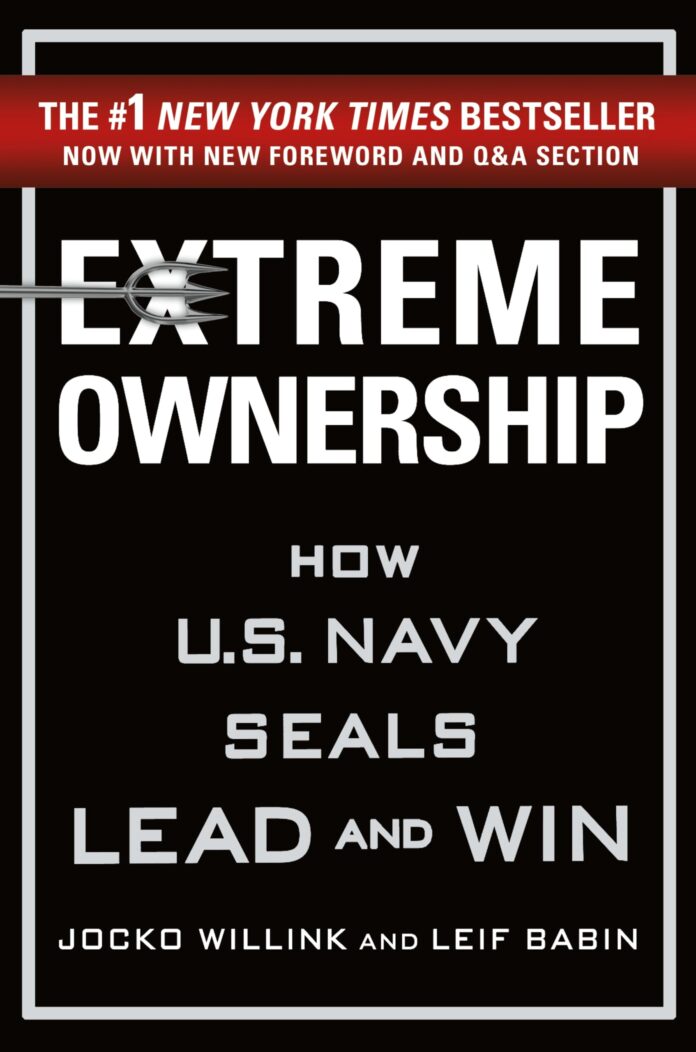In the realm of leadership literature, few titles resonate with the profound gravity and urgency of “Extreme Ownership” by Jocko Willink and Leif babin. Drawing from their experiences as Navy SEAL commanders,the authors provide readers with insights not only forged in the crucible of warfare but also applicable to everyday challenges in business,personal growth,and team dynamics. This book serves as both a riveting memoir and a practical guide, intertwining the relentless discipline of military strategy with the nuanced complexities of leadership. In this review, we will delve into the core principles articulated by Willink and Babin, exploring how the lessons learned on the battlefield can illuminate the path to transformative leadership in any arena. Whether you are a seasoned executive or an aspiring leader, the ethos of “Extreme Ownership” offers a compelling framework that challenges conventional wisdom and inspires actionable change.
Exploring the Concept of Extreme Ownership in Leadership Development
In the world of leadership, the principle of extreme ownership stands as a transformative doctrine that challenges leaders to take full responsibility for their team’s outcomes. This concept, popularized by former Navy SEALs Jocko Willink and leif Babin, underscores that effective leaders do not place blame externally; rather, they examine their own role in failures and successes. By embracing this mindset, leaders foster a culture of accountability that inspires team members to engage actively in their roles, leading to enhanced productivity and morale. Key attributes of extreme ownership include:
- Accountability: Leaders accept responsibility for all aspects of their team’s performance.
- Openness: Open communication about challenges and mistakes facilitates trust.
- Empowerment: Encouraging team members to take initiative and ownership of their tasks.
Furthermore, the request of this concept during leadership development programs emphasizes real-world scenarios that cultivate resilience and adaptability. By analyzing case studies from battlefield experiences, aspiring leaders learn to navigate high-pressure situations and make critical decisions while fostering an environment where feedback is valued. A systematic approach to this training can be organized as follows:
| Scenario | Leadership Lesson |
|---|---|
| Combat Missions | critical Decision Making |
| Rescue Operations | Team Coordination |
| Training Exercises | Feedback Acceptance |
The Impact of Military Experience on Effective Leadership Strategies
Military experience has a profound effect on developing effective leadership strategies.Leaders who have navigated the complexities of battlefield scenarios frequently enough bring a unique set of skills to their civilian roles. The high-pressure environment forces them to cultivate qualities such as decisiveness, adaptability, and team cohesion. These leaders learn that in order to succeed, they must take ownership of their decisions and the outcomes that result from them—principles that resonate deeply in corporate and organizational contexts. This ownership fosters a culture of responsibility and engagement, encouraging team members to take initiatives and contribute fully to the mission at hand.
Moreover, military leaders often become adept at strategic planning and risk management through their rigorous training and experiences. This is captured effectively in the book “Extreme Ownership,” where the emphasis lies on the leader’s role in establishing a clear vision and executing it despite challenges. Some key strategies derived from military experience include:
- Clear Communication: Ensuring that all team members understand their roles and the mission.
- Emphasis on Training: Consistent training enhances both individual and collective capabilities.
- Crisis management: Leaders learn to remain calm and solution-oriented in the face of adversity.
The battle-tested series of leadership frameworks can be encapsulated in a simple overview:
| Military strategy | Application in Civilian Leadership |
|---|---|
| Decentralized Command | Empower team members to make decisions within their scope of work. |
| Mission Clarity | Define and communicate goals clearly to align team efforts. |
| After-Action Reviews | Encourage debriefs and reflections to foster continuous enhancement. |
Key Principles of Accountability Stemming from Battlefield Scenarios
In high-stakes environments, the principle of accountability serves as a vital cornerstone for effective leadership. When the team encounters adversity,a leader must boldly assume responsibility for both successes and failures,cultivating a culture where everyone understands their role in achieving the mission. This means not only acknowledging personal mistakes but also empowering team members to own their actions, fostering resilience and innovation. as shown in battlefield scenarios, the moast effective leaders inspire their subordinates to take initiative, ensuring that every member feels a sense of agency in the face of challenges.
Moreover, establishing obvious channels of communication is essential for accountability to thrive. Leaders must articulate their expectations clearly,enabling team members to align their efforts cohesively. In this context, a leader’s willingness to solicit feedback and adapt strategies reinforces a collective commitment to continuous improvement. to illustrate these dynamics, consider the following table that outlines critical accountability attributes vital for a cohesive unit:
| Attribute | Description |
|---|---|
| Trust | Foundation of mutual reliance among team members. |
| Empowerment | Encouraging individual initiative and ownership. |
| Feedback | Open dialog for improvement and growth. |
| Adaptability | Willingness to change strategies based on real-time insights. |
Navigating Challenges: Lessons on Decision Making Under Pressure
In high-stakes environments, the ability to make sound decisions rapidly has profound implications for success. Leaders often face unexpected situations that demand clarity of thought and decisive action. Hear are some essential components for effective decision-making under pressure:
- Maintain Perspective: Step back and assess the situation holistically to avoid tunnel vision.
- Prioritize Actions: Identify what is urgent versus what is crucial to allocate resources wisely.
- Embrace Responsibility: Own your decisions, which fosters accountability and the willingness to adapt.
- Communicate Clearly: ensure that your team understands the objectives and their specific roles during critical moments.
The principles of discipline and simplicity can lead to better outcomes when under pressure. Teams that operate on clear standard operating procedures (SOPs) can navigate chaos more effectively. Consider this concise overview of key elements:
| Element | Description |
|---|---|
| Discipline | Consistent adherence to established guidelines that promote order and efficiency. |
| Simplicity | Simplifying complex plans and ensuring everyone grasps the main objectives reduces confusion. |
| Trust | Building trust within teams enhances collaboration, which is critical during high-pressure situations. |
Building Trust and Cohesion Within Teams Inspired by Military Tactics
In the realm of leadership,the principles derived from military tactics offer profound insights into fostering trust and cohesion within teams.One of the core tenets is the establishment of clear communication. Just as soldiers rely on precise, unambiguous orders to execute their missions effectively, teams in any organization thrive when their leaders articulate expectations transparently. When team members understand their roles and responsibilities, it not only enhances accountability but also cultivates a culture of support where each individual is empowered to contribute meaningfully.
Furthermore, the practice of integrated teamwork draws heavily from military operations. By leveraging diverse skill sets and perspectives, teams can tackle challenges more effectively. Leaders should focus on encouraging collaboration through regular team-building exercises and joint problem-solving sessions. This not only fortifies relationships but also builds resilience within the group. To illustrate this concept,consider the following table that outlines key elements of effective team cohesion inspired by military practices:
| Element | description |
|---|---|
| Shared Purpose | Aligning team goals with a mission statement helps unify efforts. |
| Trust-Building Activities | Engaging in exercises that develop mutual respect and reliance. |
| Constructive Feedback | Encouraging openness to critique fosters continuous improvement. |
| Recognition | Celebrating individual and team successes reinforces motivation. |
Translating Military Leadership Lessons to Business Environment
Moreover, the emphasis on clear communication in military leadership is particularly translatable to corporate settings. Effective leaders convey their vision and expectations to ensure everyone is aligned with the objectives at hand.Incorporating a structured approach to feedback can further enhance this clarity. Consider the following tactics that can bridge the gap between military strategies and business practices:
- Developing a mission-oriented mindset: Focus on the end goal and communicate it clearly to your team.
- Fostering a culture of trust: Encourage open conversations and respect different viewpoints to build strong relationships.
- Implementing rapid decision-making: Train your team to analyze situations quickly, empowering them to act decisively.
Real-Life Applications: Case Studies Highlighting Extreme ownership
Another compelling case study is from the corporate sphere, where companies like Team Rubicon, founded by veterans, exemplify the principles outlined in “Extreme Ownership.” After disasters such as hurricanes and wildfires, Team Rubicon mobilizes veterans to respond to humanitarian crises, demonstrating accountability in new environments.By instilling a culture of transparency and service, they empower their teams to take action, innovate solutions, and learn from challenges. Their leadership model demonstrates how the application of extreme ownership principles can facilitate effective communication and foster a sense of shared purpose, ensuring that every member plays a vital role in achieving organizational goals. These real-life applications serve as powerful testaments to the effectiveness of extreme ownership in enhancing both team cohesion and operational success.
The Role of Humility in Leadership as Illustrated in the Book
Within the pages of ‘Extreme Ownership’, humility emerges as a cornerstone of effective leadership. The authors, former Navy SEALs Jocko Willink and Leif Babin, demonstrate that the most triumphant leaders possess the ability to acknowledge their mistakes and learn from them. This trait not only fosters a culture of accountability but also encourages team members to voice their concerns and ideas without fear. Leaders who embrace humility can connect with their teams on a deeper level, engendering trust and loyalty.
A striking example of this principle is portrayed through the authors’ experiences in combat, where understanding one’s own limitations is vital for mission success. This can be illustrated through several key elements:
- Active Listening: Leaders who listen actively are better equipped to understand their team’s needs and adapt strategies accordingly.
- Empathy: Showing compassion enhances team dynamics and promotes a collaborative environment.
- Willingness to Learn: A humble leader continuously seeks knowledge and adapts their approach based on feedback.
This continuous cycle of learning not only boosts individual performance but also uplifts the entire team, creating a resilient unit ready to face challenges head-on. Humility in leadership, therefore, is not a sign of weakness; rather, it is a powerful tool that can transform the effectiveness of a team on and off the battlefield.
Creating a Culture of Continuous Improvement through Ownership
Embracing ownership is at the heart of fostering a thriving environment where continuous improvement becomes the norm. Leaders who instill this principle empower their teams to take responsibility for their actions and outcomes, leading to a profound shift in mindset. When individuals feel a personal connection to their work and understand that their contributions matter, they are more likely to seek innovative solutions and actively engage in problem-solving. This sense of accountability can be nurtured through practices such as:
- Open Communication: Create channels for team members to voice their thoughts and ideas freely.
- Recognizing Efforts: Acknowledge individual and team achievements to reinforce a sense of ownership.
- Setting Clear Goals: Ensure that everyone knows what is expected, providing a clear direction for improvement.
Moreover, breaking down silos within the organization is crucial for enabling a culture ripe for continuous enhancement. When teams collaborate across departments, they share insights and learnings that can lead to innovative practices and efficiencies.A structured approach to collaboration might involve:
| Collaboration Mechanism | Purpose |
|---|---|
| Cross-Functional Teams | Integrates diverse skills and perspectives for holistic solutions. |
| Feedback Loops | Encourages ongoing dialogue for iterative improvements. |
| Team Workshops | Fosters creativity and shared ownership over results. |
Overcoming Adversity: The Importance of Resilience in Leadership
Resilience in leadership is not merely a nice-to-have quality but an essential trait that distinguishes effective leaders from the rest, especially in tumultuous environments. In “extreme Ownership,” Jocko Willink and Leif Babin illustrate how navigating challenges on the battlefield mirrors the obstacles leaders face in the corporate arena. They emphasize that great leaders recognise their responsibility for failures and learn from them, transforming setbacks into opportunities for growth. This ability to rebound is crucial; it cultivates a culture of accountability and inspires teams to adopt a similar mindset.
Effective leaders can employ strategies to foster resilience,such as:
- Emphasizing teamwork: Building a cohesive unit that supports one another through difficulties.
- Encouraging adaptability: Training teams to pivot and adjust their strategies in response to changing circumstances.
- Modeling positive thinking: Displaying optimism and a solution-focused mindset even in the face of adversity.
the lessons drawn from military experiences in “Extreme Ownership” are not just theoretical; they offer tangible frameworks that leaders can apply to their own circumstances.By instilling resilience, leaders create environments where individuals not only survive challenges but thrive beyond them.
Practical Exercises to Incorporate Extreme Ownership Daily
Incorporating the principles of extreme ownership into your daily routine can transform not only your leadership skills,but also your personal effectiveness. Start with a daily reflection practice where you assess your actions and decisions from the previous day. Create a simple structure to evaluate what went well and what could be improved,ensuring you take total responsibility for each outcome.Consider asking yourself these questions:
- What choices did I make?
- How did my decisions affect others?
- what can I learn from today’s challenges?
Additionally, actively seek feedback from your peers or team members about your leadership style and decisions. This not only fosters an open environment but also demonstrates that you value their input, reinforcing the principle of ownership in a collaborative setting. To structure your feedback process, create a brief feedback form with the following categories:
| Feedback Category | Questions to Consider |
|---|---|
| Clarity | Did my instructions make sense? |
| Support | Did I provide enough support for you to succeed? |
| Communication | Was I approachable for questions or concerns? |
Tools for Measuring Success: Assessing Team Performance in Action
In the chaotic environment of the battlefield, effective leaders must constantly evaluate their team’s performance to ensure success. Key metrics for assessing team dynamics can include communication effectiveness, task completion rates, and adaptability to changing circumstances.Implementing a structured feedback loop allows leaders to identify strengths and weaknesses within their teams. This approach is not only critical in military operations but can be seamlessly integrated into corporate environments. Regular performance reviews should be complemented by open discussions, empowering team members to voice their insights and suggestions.
Utilizing technology can enhance the measurement of team performance considerably. Tools such as project management software and performance tracking applications enable leaders to quantify efforts and outcomes. In addition, leaders should focus on identifying pertinent success indicators that reflect their unique objectives. A simple table of key performance indicators (KPIs) can provide clarity:
| Indicator | Description | Importance |
|---|---|---|
| Team Collaboration | Measures how effectively team members work together. | High – fosters innovation and efficiency. |
| Task Efficiency | Tracks time taken to complete key assignments. | Medium – identifies bottlenecks. |
| Employee Engagement | Assesses team morale and commitment to goals. | High – boosts productivity and retention. |
Critical Reception: How readers Have responded to the Book’s Insights
Since its release, “Extreme Ownership” has sparked extensive discussion among readers, many of whom appreciate the book’s practical applications of military principles to everyday leadership challenges. The authors’ straightforward anecdotes, drawn from their experiences in Navy SEAL operations, resonated deeply with readers from diverse backgrounds, from corporate executives to team leaders in various industries. Key insights that garnered praise include:
- The importance of accountability: Readers highlighted how taking ownership of successes and failures fosters trust within teams.
- Effective communication: The emphasis on clear and concise messaging was considered instrumental in both military and business environments.
- Team dynamics: Many have found that the principles outlined encourage collaboration and build a culture of mutual respect.
However, the book has also faced criticism, with some readers arguing that its military metaphors might not always translate well to civilian life. They occasionally point to a perceived lack of nuance in complex organizational challenges that demand more than the clear-cut tactics presented. Despite this, the overwhelming response has been positive, as many find themselves invigorated by the authors’ call to lead from the front and embrace failure as an essential component of growth. In a survey capturing reader sentiments, the following table illustrates the balance of opinions:
| Feedback Category | Percentage of Readers |
|---|---|
| highly Positive | 65% |
| Moderately Positive | 25% |
| Neutral | 5% |
| Critical | 5% |
A Final Reflection on Jocko Willink’s Influence in Leadership Dialogue
as we delve into the impact of Jocko Willink on contemporary leadership dialogue, it’s clear that his teachings transcend the confines of military strategy. His principle of extreme ownership serves as a beacon for leaders across various sectors, emphasizing personal accountability in every action taken within an organization. Leaders who embody this ethos are not only able to navigate challenges more effectively but also foster a culture of trust and responsibility among their teams. Key aspects of his influence include:
- Clarity in Communication: Willink advocates for straightforward dialogue,ensuring that all team members understand their roles and expectations.
- Leading by Example: True leadership emerges when one is willing to accept the consequences of their decisions and inspire others through their actions.
- Resilience in Adversity: The ability to maintain composure and adapt in high-pressure situations is a valuable skill emphasized by Willink.
Furthermore, Willink’s approach encourages leaders to view challenges as opportunities for growth, which is a potent mindset in today’s fast-paced business world. His insights not only inspire military leaders but also resonate with corporate executives seeking to enhance team dynamics and productivity. To encapsulate the essence of Willink’s philosophy, consider the following table that showcases the core elements of effective leadership:
| Leadership Trait | Description |
|---|---|
| Accountability | Recognizing and owning one’s decisions and their outcomes. |
| Decisiveness | Making timely decisions with confidence based on available information. |
| Empathy | Understanding team members’ perspectives to foster a supportive environment. |
| Continuous Improvement | Seeking feedback and learning from mistakes for ongoing development. |
Insights and Conclusions
“Extreme Ownership” invites readers to step into the high-stakes world of military leadership and emerge with practical wisdom applicable to any arena of life. By dissecting the principles gleaned from the battlefield,Jocko Willink and Leif Babin illuminate a path of accountability,teamwork,and resilience. Their lessons resonate not only within the confines of military strategy but also in the broader context of personal and professional growth. As we navigate our own challenges, be they in the boardroom or at home, the essence of extreme ownership reminds us that true leadership begins with an unwavering commitment to take responsibility for our actions. Whether you’re a seasoned leader or an aspiring one, this book serves as an essential guide, encouraging us all to embrace the lessons learned from war and apply them to our own journeys. So, as we close this chapter on “Extreme Ownership,” let us carry forward the baton of accountability, reminding ourselves that in every setback lies the potential for growth and mastery.










